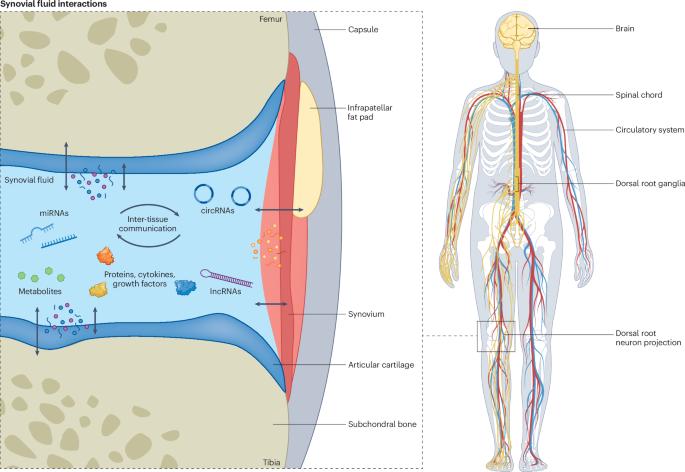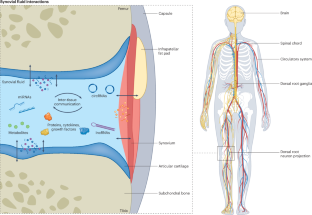滑液作为一个复杂的分子池,有助于膝关节骨关节炎
IF 32.7
1区 医学
Q1 RHEUMATOLOGY
引用次数: 0
摘要
滑液的主要自稳态功能是关节润滑。然而,在膝骨关节炎(KOA)期间,滑液会随着疾病的驱动因素而改变,从而导致症状(疼痛)和关节相关病理。作为来自体循环和局部组织(包括关节软骨、软骨下骨、滑膜和髌下脂肪垫)的因子汇,滑膜液能够双向交流,促进KOA的发病。滑液成分也可能在循环中检测到,不仅作为可获得的生物标志物,而且作为koa驱动的全身效应的潜在介质。沉积在滑液中的因子有影响神经系统活动的能力,作用于从背根神经节进入关节组织的神经元突起。KOA滑膜液的非编码rna (microrna、长链非编码rna、环状rna)、代谢物、细胞因子和其他分泌蛋白已成为疾病进展、治疗效果和疼痛的生物标志物。这些分子也可能作为KOA的分子介质,支持它们作为治疗干预的候选物。本综述整合了过去4年发表的文献,重点关注滑液中确定的作为KOA症状和病理的生物标志物和分子介质的因素。新兴的治疗方式,以靶滑液分子介质也进行了讨论。本文章由计算机程序翻译,如有差异,请以英文原文为准。


Synovial fluid as a complex molecular pool contributing to knee osteoarthritis
The main homeostatic function of the synovial fluid is joint lubrication. However, during knee osteoarthritis (KOA), synovial fluid becomes modified with drivers of disease that contribute to symptoms (pain) and joint-related pathology. Acting as a sink of factors from both systemic circulation and local tissues, including articular cartilage, subchondral bone, synovium, and the infrapatellar fat pad, the synovial fluid enables bidirectional communication promoting KOA pathogenesis. Synovial fluid constituents might also be detected in circulation, functioning not only as accessible biomarkers but also as potential mediators of KOA-driven systemic effects. Factors deposited in synovial fluid have the ability to affect nervous system activity, acting at the neuronal projections that are integrated into joint tissues from dorsal root ganglia. Non-coding RNAs (microRNAs, long non-coding RNAs, circular RNAs), metabolites, cytokines and other secreted proteins of the synovial fluid in KOA have emerged as biomarkers of disease progression, therapeutic efficacy, and pain. These molecules might also function as molecular mediators of KOA, supporting them as candidates for therapeutic intervention. This review consolidates literature published primarily within the past 4 years, focussing on factors identified within synovial fluid as biomarkers and molecular mediators of KOA symptoms and pathology. Emerging therapeutic modalities to target synovial fluid molecular mediators are also discussed. The synovial fluid lubricates joints while also collecting molecular mediators from surrounding tissues. This Review highlights how molecular analyses of the synovial fluid might provide information on the progression of knee osteoarthritis and treatment efficacy, and identify potential therapeutic strategies targeting synovial fluid mediators in knee osteoarthritis.
求助全文
通过发布文献求助,成功后即可免费获取论文全文。
去求助
来源期刊

Nature Reviews Rheumatology
医学-风湿病学
CiteScore
29.90
自引率
0.90%
发文量
137
审稿时长
6-12 weeks
期刊介绍:
Nature Reviews Rheumatology is part of the Nature Reviews portfolio of journals. The journal scope covers the entire spectrum of rheumatology research. We ensure that our articles are accessible to the widest possible audience.
 求助内容:
求助内容: 应助结果提醒方式:
应助结果提醒方式:


